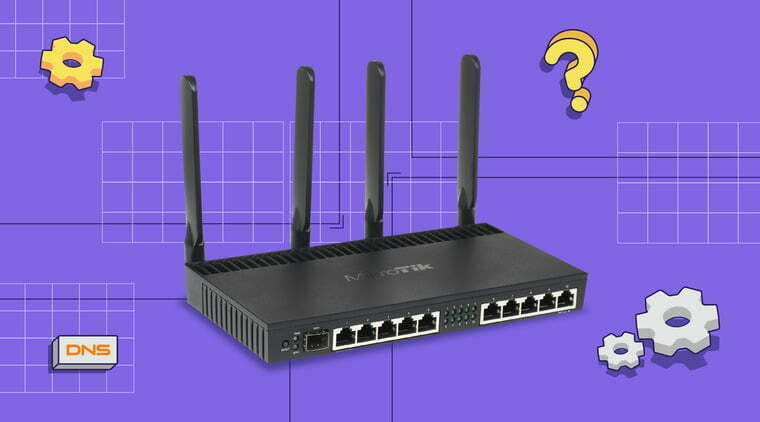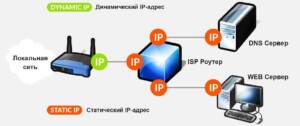- Introduction to routing and its importance in networking technologies
- Basics of routing: what it is and what problems it solves
- Why are network masks needed and how are they used by routers
- Main types of routing and their advantages
- Static routing: principles and features
- Dynamic Routing: How Routing Protocols Work
- How to choose and configure a router for your network
Introduction to routing and its importance in networking technologies
Routing is the process of transferring data from one network to another, including choosing the best route for delivering data packets. Routers play an important role in networking technology by providing connections between different devices and networks. They work at the network protocol level and determine the best path for sending data, and also perform traffic control and network security functions. Routing allows communication between different types of networks, for example, between a local network and the Internet. Each router has a routing table, which contains information about the network topology and optimal routes for data transmission. When a data packet arrives at a router, it uses this table to determine the next hop to send the data to. Routing is a key function of networking technology and allows for reliable and fast connections between different devices and networks. Understanding the basics of routing and routers can help you configure and optimize networks, and improve the security and efficiency of data transmission.
Basics of routing: what it is and what problems it solves
Routing is the process of transmitting data between network devices such as computers, routers, and switches. It is used to determine the best path for data to travel from the sender to the receiver. Routing plays an important role in the operation of the Internet because it allows many networks and devices to be connected.
One of the main problems that routing solves is choosing the optimal route for data transmission. Depending on the current load on the network, the quality of the connection and other factors, the router can choose different paths for data delivery. This allows you to increase data transfer speeds and improve network reliability.
Another problem that routing solves is protecting the network from external threats. Routers can be used to filter traffic and block suspicious connections. They can also be used to organize virtual private networks, which provide secure communication between remote devices.
Overall, routing is an important component of any network. It helps optimize data transmission, improve network reliability, and ensure the security of transmitted information.
Routers use routing tables to determine the best path to forward data. These tables contain information about the networks to which the router can route data packets, as well as which router interface should be used to deliver the packets.
When a router receives a data packet, it looks at the destination address in the packet header and compares it with entries in the routing table. If the router finds a matching entry, it will forward the packet to the appropriate interface and continue forwarding data.
If a router does not find a matching entry in the routing table, it can use a routing protocol such as OSPF or BGP to obtain information about the networks to which it can route data packets. The router can also use static routes that have been manually entered by the administrator.
Routing tables can be complex, especially on large networks with many routers and networks. However, these tables are key tools for ensuring efficient and reliable data transfer across the network.
Routers are a key element in network infrastructures as they enable data transfer between various devices on the network. One of the main jobs of a router is to make decisions about data transmission based on IP addresses and network masks.
An IP address is a unique identifier for a device on a network, consisting of four numbers separated by periods. The network mask specifies which part of the IP address refers to the network and which part refers to the device on that network.
When a router receives a data packet, it checks the destination IP address and compares it with the routing table. This table shows the routes for the various subnets and the interfaces through which the router must send the data packet.
If the router does not find an exact match in the routing table, it uses the subnet mask to determine which subnet the destination IP address belongs to. The router then selects a route for the most appropriate subnet and sends the data packet through the appropriate interface.
It is important to note that routers can use multiple routes to deliver a data packet if there are multiple possible paths. In this case, the router selects the optimal route based on various factors such as throughput and latency.
In general, routers play an important role in ensuring efficient data transmission in networks. Their ability to work with IP addresses and netmasks allows them to determine the most appropriate route for transmitting data packets.
An IP address is a unique identifier assigned to each device connected to a network. It consists of four numbers separated by periods and may look like 192, for example.
168.
0.
1. IP addresses are used in routing data on the network. When you make a request to a website, your computer sends a data packet containing your IP address to the router, which performs the function of 'switching' data packets between devices on the network. A router uses IP addresses to send data packets along the most efficient path to their destination. This allows you to speed up data transfer on the network and make it more efficient.
Why are network masks needed and how are they used by routers
Netmasks are special numbers that are used to determine which bits in a network's IP address relate to the network address and which bits relate to the address of a host on that network. Without the use of network masks, routers will not be able to correctly determine where to send data packets, and the network will not function.
The netmask is a series of ones followed by zeros. For example, if the netmask is 255.
255.
255.
0, then the first 24 bits of the IP address refer to the network address, and the last 8 bits refer to the host address. As a result, a given network can have up to 256 nodes.
Routers use netmasks to determine the most appropriate route for data transmission. If there are multiple routes in the routing table for the same network, the router will choose the one with the most matching bits in the netmask.
For example, if there are two routes in the routing table for network 192.
168.
0.
0/24 – one via eth0 interface with mask 255.
255.
255.
0, and the other through the eth1 interface with a mask of 255.
255.
0.
0, the router will choose the route through eth0 because this route has more bits matching the destination address.
It is important to understand that using the wrong network mask can result in hosts on the network being unable to communicate with each other or with devices on other networks. Therefore, when setting up a network, you need to make sure that all devices use the same network masks.
Main types of routing and their advantages
Routing is the process of transferring data between different devices on a network. In order for this transfer to be successful, the route must be chosen correctly. There are three main types of routing: static, dynamic and hybrid.
Static routing assumes that routes are set manually by the network administrator. This type of routing is the simplest, but inconvenient to use. If changes occur in the network, for example, adding new devices, then you must manually change the routes.
Dynamic routing is the automatic selection of a route based on information about the state of the network. The advantage of dynamic routing is the ability to change routes automatically when the network state changes. The disadvantage is the high load on the router's processor and the risk of a routing loop.
Hybrid routing is a combination of static and dynamic routing. In this case, the administrator sets the main routes, and routes to specific devices are determined automatically.
Each routing type has its own advantages and disadvantages, so the most appropriate routing type must be selected for each network.
Static routing: principles and features
Static routing is the process of establishing routes manually, without the use of routing protocols. It is used in small networks where the number of nodes is limited and changes in the network topology are rare.
To configure static routing, you need to determine the IP addresses of the nodes between which data will be exchanged. Next, you need to configure routes by specifying the IP addresses of the hosts through which the data should pass.
Static routing has its advantages and disadvantages. Its advantage lies in ease of configuration and reliable operation with a small number of nodes. However, it is ineffective in large networks where the number of nodes is large and changes in the topology occur frequently.
In general, static routing is suitable for small networks where high performance and configuration flexibility are not required. In other cases, it is recommended to use dynamic routing, which automatically configures routes based on information about the network topology.
Dynamic Routing: How Routing Protocols Work
Routing protocols are software algorithms that are used by routers to determine the optimal path for data transmission on a network. There are two main types of routing protocols: static and dynamic.
Static routing is a manually configured routing table that tells routers how to forward data. This technique is simple and reliable, but requires constant maintenance and updating if the network topology changes.
Dynamic routing, in turn, allows routers to automatically analyze the network and determine the optimal routes for data transmission. Routing protocols such as OSPF, EIGRP, and RIP are used to exchange network topology information and configure routing tables.
With dynamic routing, routers automatically detect changes in network topology and rebuild routing tables to ensure optimal data transfer. This approach is more flexible and efficient than static routing, but requires more resources and configuration.
In general, dynamic routing is the preferred solution for medium to large networks that need to quickly detect and adapt to changes in the network topology.
How to choose and configure a router for your network
A router is a network device that allows you to manage data transfer between different networks. It plays an important role in building modern computer networks and has many functions such as traffic filtering, packet forwarding and bandwidth management.
When you choose a router for your network, there are several factors to consider. First, you must decide which devices will connect to the network and how much data needs to be transferred. Second, make sure the router meets your needs for speed and reliability. Third, check if the router supports the protocols and features you need, such as VPN, QoS, etc.
d.
Additionally, after purchasing a router, you must configure it. There are several ways to configure your router, but the most common is to use the web interface, which allows you to manage your router settings through a browser. You need to enter the router's IP address in the browser and enter your username and password to access the settings. After this, you can change various settings such as Wi-Fi password, security settings, port settings, etc.
d.
It is important to remember that incorrect router configuration can lead to network vulnerabilities and data loss. Therefore, if you are not confident in your abilities, it is better to seek help from specialists.
Ultimately, choosing and configuring a router are key steps in building a modern computer network. We hope this article will help you make the right choice and configure a router for your network. Key characteristics of routers play an important role when choosing a device for your home or office network. First of all, you need to pay attention to the data transfer speed, which is determined by the maximum speed of the ports and support for Wi-Fi technology. Also important is the number of ports and support for various protocols. To protect your network from external threats, you need to pay attention to the presence of security features such as traffic filtering, VPN, etc.
Finally, ease of use and additional features such as voice commands and mobile app control can make choosing a router even more attractive. Setting up a router to work on your network goes through several basic steps.
The first step is to connect to your computer via an Ethernet cable or wireless network.
Next, you need to go to the router settings, which are usually accessible through the web interface.
In this interface, you can configure basic network settings such as IP address and subnet mask.
You can also configure network security, including your router password and firewall settings.
Other important settings that can be configured in a router include port settings, VPN settings, and advanced features such as QoS (Quality of Service).
Overall, setting up a router to work on your network can be quite simple if you are familiar with the basics of network administration.
However, if you encounter any difficulties, you can always consult the user manual or network technicians for help.
Read further:






